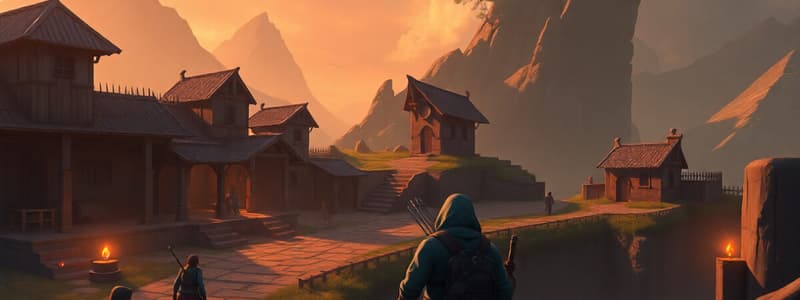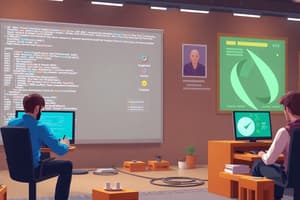Podcast
Questions and Answers
What is the primary purpose of the premise in an RPG?
What is the primary purpose of the premise in an RPG?
- To dictate the game mechanics
- To summarize the game's graphics
- To provide a summary of the game’s purpose and overall concept (correct)
- To list the characters involved
Dramatic tension is maximized when a player is consistently in a position of safety.
Dramatic tension is maximized when a player is consistently in a position of safety.
False (B)
What role does the guardian play in the story structure of an RPG?
What role does the guardian play in the story structure of an RPG?
The guardian tests the hero and blocks their progress until they prove their worth.
The plot focuses on how the story unfolds rather than what the story is about, indicating that it is more about the __________ of events.
The plot focuses on how the story unfolds rather than what the story is about, indicating that it is more about the __________ of events.
Match the following story elements with their descriptions:
Match the following story elements with their descriptions:
What is the primary function of the herald in a story?
What is the primary function of the herald in a story?
The protagonist of a single-player game is always morally good.
The protagonist of a single-player game is always morally good.
Define the term 'Suspension of Disbelief'.
Define the term 'Suspension of Disbelief'.
A _____ is a character that thrives on making mischief, often providing comic relief.
A _____ is a character that thrives on making mischief, often providing comic relief.
Match the following character archetypes with their descriptions:
Match the following character archetypes with their descriptions:
Flashcards are hidden until you start studying
Study Notes
Game Plotting
- Game plotting is part of a game’s story structure but can be dictated by how the game is played
- Players make decisions and experience challenges, driving the story toward a climactic event and resolution
Balancing Conflict
- The player should be on the brink of disaster
- The player should be able to escape, repeatedly by the narrowest of margins.
Shifting Focus
- Players can be drawn back to the main storyline.
- The scope of the game could be widened by subquests, new characters, or objects, leading to unexplored areas.
Suspension of Disbelief
- Players should accept the artificial reality created in the game
- Players should accept the rules and experiences that might not make sense in the real world
- Examples include flying in-game without aircraft, or an in-game rule that all humans are evil, while hideous demons are good.
Realism
- Players want to experience realism and authenticity
- Games should mimic the real world as closely as possible.
Character Archetypes
- Hero: The protagonist, acting instead of reacting, making things happen
- Shadow: The opposite of the hero.
- Mentor: Guides the hero on their journey
- Ally: Assists the hero
- Guardian: Blocks the hero’s progress until his or her worth has been proven
- Trickster: A neutral character who enjoys making mischief, often providing comic relief
- Herald: Facilitates change and provides direction
- Antagonist: The opposite of the protagonist.
- Unity of Opposites: When protagonist and antagonist want the same thing (e.g., love interest)
- Transformational Antagonist: An anti-hero character who could have been a protagonist, receiving punishment at the end of the story.
- Mistaken Antagonist: Initially thought to be a villain, but turns out to be innocent.
- Exaggerated Antagonist: Larger-than-life and bizarre villains.
Supporting Characters
- Also known as pivotal characters
- Prevent the protagonist from walking away
- Jump-start the action
- Carry out the antagonist’s bidding
- Bring a variety of viewpoints.
Game Characters
- Player Characters (PCs) Controlled by players
- Avatar A Player Character (PC) completely controlled by one player
- Non-Player Characters (NPCs) Characters controlled by an artificial intelligence engine (AI).
Character Arc
- Character growth and development
- Illustrated through a character’s behavior
- Based on Maslow’s Hierarchy of Needs model
Levels of Character Development
- Intrapersonal: Protagonist concerned only with their own needs and thoughts.
- Interpersonal: Protagonist bonds with another character in a one-on-one relationship
- Team: Protagonist bonds with a small group of characters with common interests
- Community: The smaller team becomes part of a larger group, such as a neighborhood, city, or school
- Humanity: Protagonist experiences a sense of self-actualization, spiritual growth.
Studying That Suits You
Use AI to generate personalized quizzes and flashcards to suit your learning preferences.





